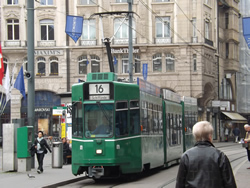
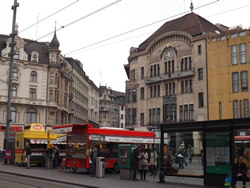
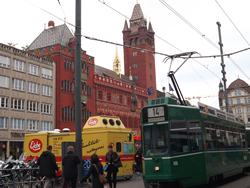
|
Any comments or questions please contact us: kevin@sailawayonline.co.uk or ann@sailawayonline.co.uk (Please note our reply depends on available internet access, we will reply to you as soon as possible.) |
I - The long road journey from the UK to Kas, Turkey, begins.
To view our previous log entries please use the following link:
Turkey XIV (2012) - The Lycian Coast IV, Kas, Sailaway's home for some time to come.
To view our next log entries please use the following link:
II - The Long Journey continues, from Basel to the Swiss/Italian Lakes.
Log Entry Monday 22nd April - We use the tram to take us into Basel old sector? (200)
 |
 |
 |
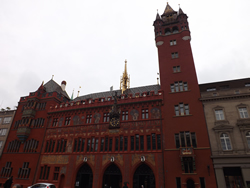 |
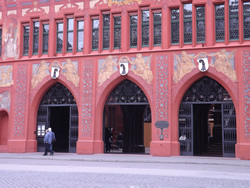 |
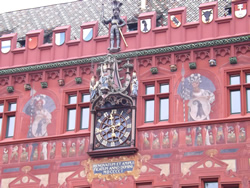 |
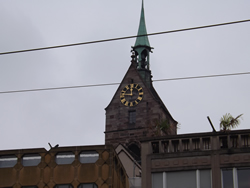 |
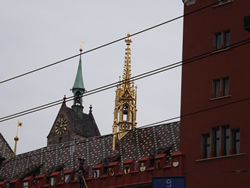 |
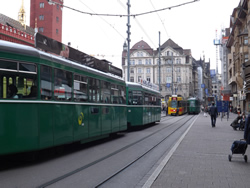 |
We today obtain a couple of tram passes for the day and head into the city centre, we are a little apprehensive as when driving through from north to south yesterday the city seemed "face less". It has the look of a very modern, commercial development, in comparison to many cities all relatively new - it was only through a little available research we we convinced to even make the short trip in? The tram and train net work is again superb as most European cities, the UK claim to be "green" but have discarded tram systems and chosen for noisy dirty diesel buses? Even small to medium size towns have a tram system, completely green almost noise free? When making some general enquires at the tram stop, i.e. "are we going the right way?" we are advise to continue on and disembark at "Markplatz", described as the "true old centre." The tram only took 10-15 minutes to get us there, again through almost a face less "shopping mass". Eventually we arrive at Markplatz and get off, we are very surprised at what we see and the surroundings, aged buildings, very colourful in design and a small open market just off the tram stop, the square is busy. The whole square is dominated by one of the "city authority" buildings, but again because of close proximity of all built around it was impossible to capture a detailed single photograph.
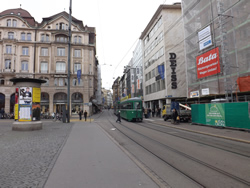 |
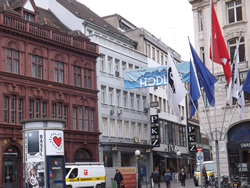 |
We spend time wandering around the square, looking at the meats and produce in the local market, it was then time to grab a coffee and take a good look at our city map?
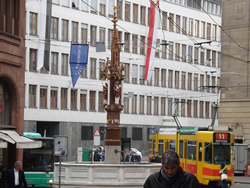 |
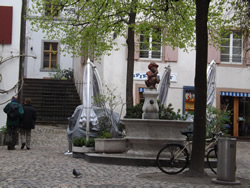 |
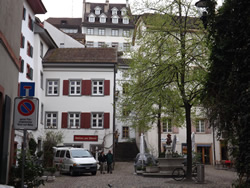 |
The next stop was the "Historic Museum", situated in another small square to the southwest, to please our eyes the building remain colourful and some what dated.
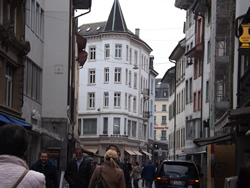 |
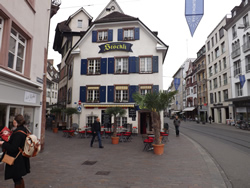 |
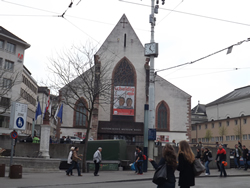 |
We eventually reach the museum, making our way through the hustle and bustle of any, typical city. It was at a small kiosk when we purchase a 500ml bottle of diet coke it was brought to our attention as to just how expensive the city/Switzerland is - we paid just over £3.00 in Swiss Francs!
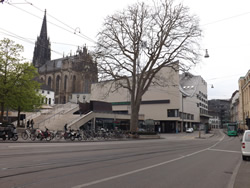 |
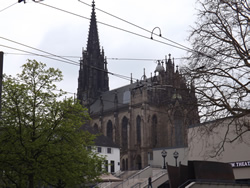 |
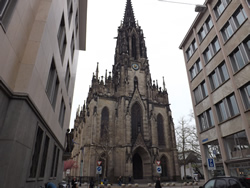 |
We then turned towards one of the many proud churches in the city off "Elisaberthenstrasse", the name of the street attracting our notice? The church was truly magnificant, how it had been preserved through time and history was quite astounding. Along side stood the City Theater, in comparison completely new and very modern, the fact, the church was surrounded on all sides by concrete and glass.
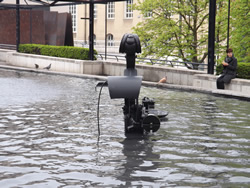 |
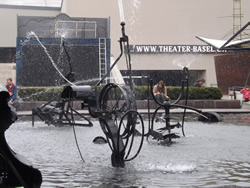 |
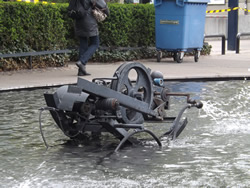 |
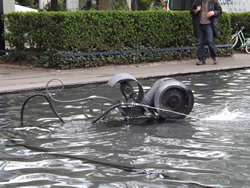 |
In front of the church and theater stood an art structure, a series of automated, moving "works", all powered by water, very interesting I could have sat there for hours, as many people obviously do!
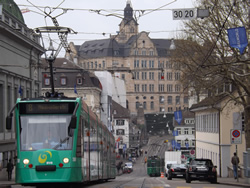 |
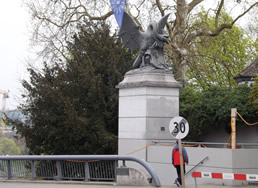 |
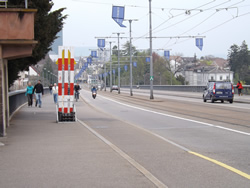 |
We then head only a couple of hundred meters on to "Wettsteinbruke", the main bridge spanning the Rhine. As we stood in Switzerland, looking across it to the north, approx. 1500 meters "Germany", and more to the northwest, a similar distance, "France". In fact to confuse issues further we are to see and stay with friends tonight, 22 miles to the north in Germany! This border hopping is very unusual to us but at times can be quite defined, currency can change (e.g. Swiss Francs to Euro) even the language on the car radio stations service the various nationalities. At the moment, my left pocket hold Francs and my right Euros, however as one might appreciate dual currency is some times an option?
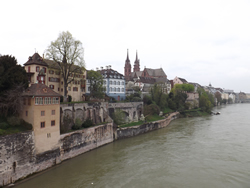 |
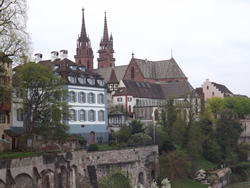 |
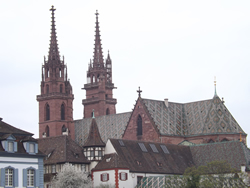 |
As one looks to the north passage of the Rhine the "Münster" building is very dominant with its typical colourful roof and towers soaring high above the surrounding buildings.
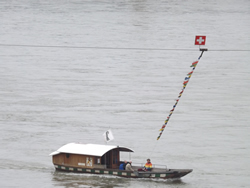 |
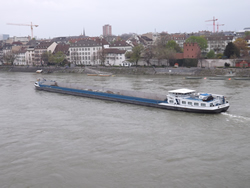 |
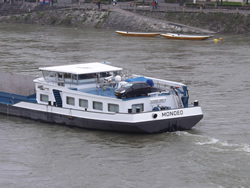 |
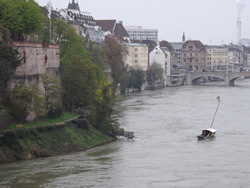 |
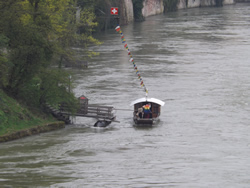 |
The Rhine is an extremely busy waterway cutting its way through Europe and finishing at the delta in the Black Sea far to the east. Here we watch many commercial river craft pass under the bridge, some even carry their own vehicles? The river in this area is serviced by four, electric, tram type ferries, all river craft passing under their electric cables. We watch as the "Münsterfähe" operates, gliding at an angle to compensate for the fast running water underneath it's hull. It appears to just touch the pontoon and the passengers disembark - no tying up?
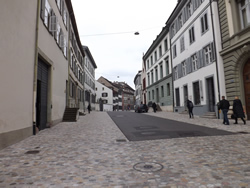 |
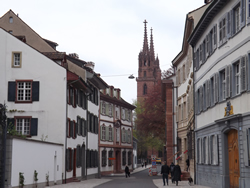 |
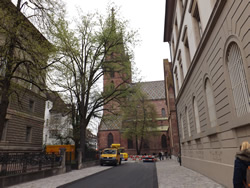 |
We then make our way to "Münsterplatz" through what appears to be a very private select urban area parallel to the Rhine.
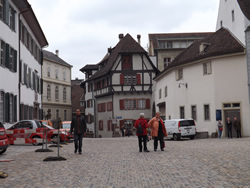 |
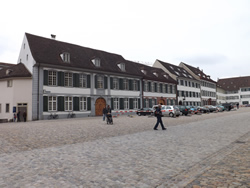 |
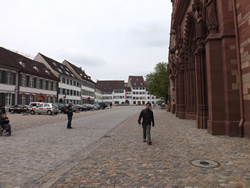 |
The square itself is quite breath taking, four or five further museums not yet open to the public.
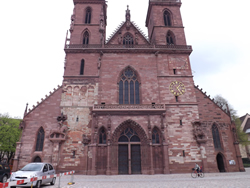 |
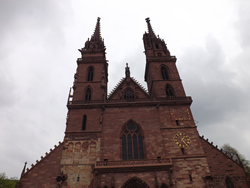 |
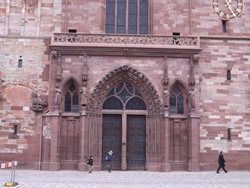 |
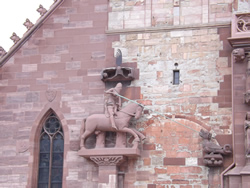 |
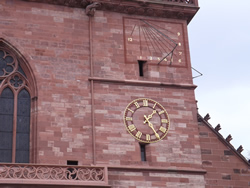 |
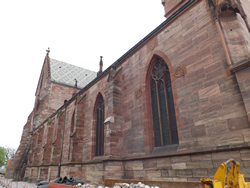 |
The Münster is a tremendous building, again difficult to photograph with our camera.
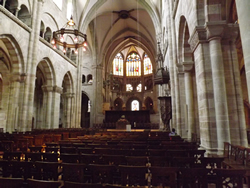 |
 |
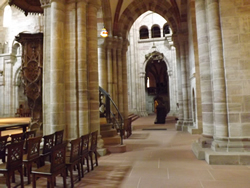 |
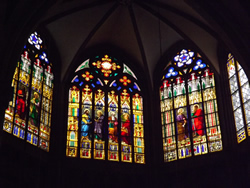 |
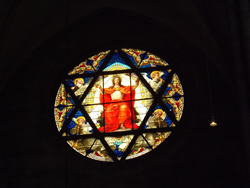 |
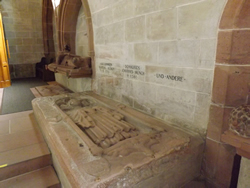 |
The internal structure just as impressive with origins dating back to the beginning of Christianity.
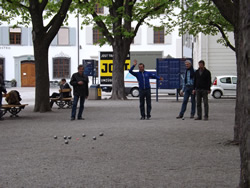 |
Outside the local guys occupying themselves in a very competitive manner.
We were very pleased with our findings, initially we had been a little disappointed, but there, as in many cities such a large area of interest in a very small area.
Log Entry Saturday 20th April - We leave Antwerp, and move on towards Basel, Switzerland - we do not quite make it today?
With still almost 100 miles to cover to Basel, it approaches 5pm, we know from experience that at this time of year the site office will be closed, as tiredness creeps on we decide to pull off and find local accommodation. We drive towards two local French campsites, both have not even open yet, too early in the season - so a hotel it is to be? There is no real hurry as we know there is heavy rain ahead.
 |
 |
 |
We end up in a very small village called "Wisembach," 90km south of Nancy, France the hotel called "du Blanc Ru". It is a small established with good parking to hide our packed car from sight, very warm and friendly. No English is spoken but we stumble through with our broken French. We had already eaten on the way down so we had only bread and a cheese board to complement the local wine? The restaurant clearly at that time of year serviced the locals only so it was quiet, there was only one other guest? It was a pleasant evening, the room lovely and warm.
 |
 |
 |
In the morning, after our coffee we had a walk around the village, it is set in the "Vosges Mountains" and forests, unfortunately most hidden by the low cloud and mist.
 |
 |
 |
It only takes us ten minutes to walk the village, it is Sunday morning but it is probably not much busier at any other time?
 |
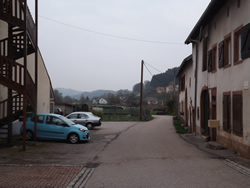 |
 |
We set the nav system for Basel, we are taken up over the hillside deep into the low cloud, the scenery hidden from the eye?
 |
 |
 |
We very quickly disappear from all evidence of other human existence, we hardly see another vehicle for some time?
 |
Driving through the "Vosges Mountains" , it is evident that there is a strong/substantial mineral mining industry. We drop down to a lower region busy with agriculture, especially wine, both growing and processing. It seemed strange to have driven on such terrain after such a long period of relatively flat driving on our way south?
 |
 |
We eventually arrive in Basel and make for our planned campsite, both "plant" (our four cactus bowl) and cuddles are lasting the trip well. We had sat tight further north knowing of the past two day downfall of rain, snow on the Alps ahead? Ann makes an excellant suggestion and builds a patio from thick cardboard to reduce the transfer of mud into our tent - what a clever girl!
Log Entry Thursday 18th April - We arrive at Antwerp, Belgium to primarily visit the historic town Centre.
The trip to Antwerp is based on my previous time spent on a project there, to visit the "old town" allowing Ann to experience the surroundings and culture?
 |
 |
 |
We no sooner have our tent erected and we are visited by the local bird life, ducks and magpies arrive to "greed" from us - they are clearly used to humans and show little fear of us, we feed them well. During our two night stay, as soon as we appear, they greet us with "expectations".
 |
 |
 |
We take directions from the extremely helpful guy that checks us onto the site, our plan is to walk down the riverside, through the park and cross the river "Schelde" via a pedestrian tunnel that runs parallel to a road tunnels. The tunnel is know as "Welgangerstunnel" the pedestrian tunnel was build between 1931-1933, is 527 meters long and lies about 31 meters under the ground. To get down to it you have to take the elevator or the escalators, we are told it is still serviced by the original escalators, built in the 1930's from wood?
The campsite is located in a very select area slightly west of the city, it boarders with the river and marina - brings back pleasant memories?
 |
 |
 |
The river Schelde is approximately 350 km long, wandering through northern France, western Belgium and the southwestern part of the Netherlands and has served as a primary source of transportation for centuries. It is still very busy with numerous freight vessels passing through as we walk the path through the park, the city provides a nice backdrop.
 |
 |
 |
The park is quite busy, noticeably very clean and appears void of litter and graffiti?
 |
 |
 |
The park is decorated with a very nautical theme, climbing frames constructed from river buoys, and a massive viking longboat.
 |
 |
 |
Eventually we arrive at the tunnel entrance, we choose the escalators over the lifts, both are used by the cyclists without any issues?
 |
 |
 |
Some cyclists use the elevator, not even the need to dismount, they cycle in, sit, wait and ride out as the opposing doors open. The 500m tunnel itself although shown quite empty in the pictures was very busy, cyclists passing at speed again without issue. We, being British are wondering about "heath & safety rubbish" - once again we are shown by other nationalities that harmony can exist without legislation!
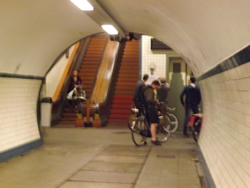 |
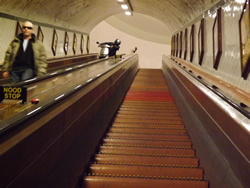 |
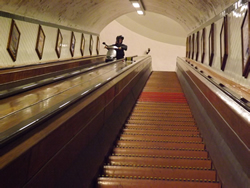 |
We walk the 500 metres or so to the end of the tunnel and ascend again by the extremely noising, ancient escalators, what a great experience!
 |
 |
 |
We exit at ground level through a much smaller, more discrete building than we entered, out into the centre of Antwerp just a couple of hundred meters from our target area.
 |
 |
 |
We make our way toward the "Grote Market" in which the Notre-Dame Cathedral sits.
 |
 |
 |
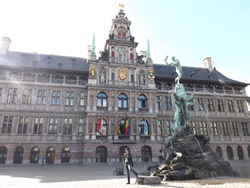 |
 |
 |
 |
 |
The square is just as elegant as I remember, very ornate with the chamber buildings, all highly decorated and colourful. The square's perimeter lined with restaurants, many not yet open due to the time of the year.
 |
 |
 |
The Cathedral is just as magnificant, as we had witnessed from the park as we walked on the other side of the Schelde. The difficulty one has trying to capture its true beauty on camera is that it is too large a structure to fit in from such a close proximity.
 |
 |
 |
The magnificant buildings and small squares are too numerous, each one named and associated with historical events.
 |
 |
 |
We decide after a couple of hours walking to do one of the most important things to do in Belgium - drink "Trapiest Beer", originating from distillation by the monks the beer has a world wide reputation. They are numerous in styles, taste and strength, the norm is around 16 - 18% alcohol, some stronger, stronger than most wines!
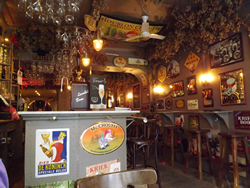 |
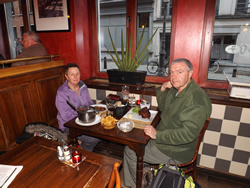 |
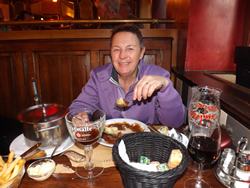 |
We pick a small bar in one of the adjacent side streets, not too far from the square as I wanted Ann to see the lit square by night. The bar we chose "Antwerp's Bierluwyske" boasted 250 Trapiest beers, we were presented with a menu, but for ease we started at No 1! After a couple of hours/beers we sought advise on some where reasonable to eat with good Belgium food - the proprietor was extremely helpful, her recommendation was excellant. We enjoyed a rich meal of seafood, giant king prawns, snails in garlic, beef both stew and ribs, to wash it down a couple of more beers.
 |
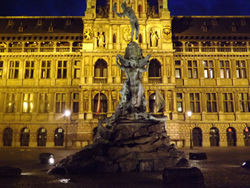 |
 |
 |
 |
 |
With our stomachs completely full we made our way back outside into the now darkened square, we were taken by the lighting of the whole area, nothing left to do but catch a taxi back to bed - a great day!
Log Entry Wednesday 17th April - We return to Dunkirk to look around, first stop Dunkirk Cemetery (The British Memorial), then onto the Museums.
Our return, 15 miles west to Dunkirk is a planned one, to try and understand in greater detail exactly what happened at "Operation Dynamo", the evacuation of our troops from Dunkirk May-June 1940?
 |
 |
 |
 |
 |
We mistakenly wander into the main cemetery initially and are somewhat taken by the efforts under taken with the grave stones/monuments, so much squeezed into such a small space? There are clearly a vast number of graves visited by surviving friends and family, all is kept in good repair and decorated regularly with flowers etc, many of the tombs containing whole families or multiple generations? As we walk through we eventually determine that the British Memorial has a separate entrance off the adjoining main road, we make our way back towards the exit and onto the main road. There is, as in all cemeteries one expects, an area clearly put aside for the poorer, some graves marked with only a single wooden cross, still the vast majority beautifully decorated.
 |
 |
 |
As we enter the Memorial (originally erected in 1957) one is overcome by atmosphere as you walk past the large "Portland Stone Pillars" listing the 4528 "missing in action", soldiers of the British soldiers from the 110 different regiments who unfortunately lost there lives during the conflict. Lying adjacent to the pillars are a further 810 graves of soldiers - quite horrific when one considers, not only their deaths but also those left behind, family, friends etc?
 |
 |
The Memorial Building has windows displaying the evacuation, able soldiers assisting the wounded to the vessels off shore - ones hairs on ones arms stand up as you gaze at the destruction portrayed.
 |
In the centre of the building is a concealed register, we open it and read some of the comments, many pledging never to forget those that had died. We feel we should add to the register, in the comments we wrote "Many thanks for all you gave" and left the sad but necessary place, so people do not forget what was given by those and many others?
The Dunkirk Museum.
 |
We make our way from the cemetery across town to the Dunkirk War Museum, it is situated just off the dockland/harbour development. We are met at the entrance by an extremely polite and helpful French gentleman, he explains we are the only visitors and gives us a shorted guided tour. We are then lead into a small cinema to watch a ten minute movie of "Operation Dynamo" made up from actual footage source from numerous nationalities.
 |
 |
 |
 |
 |
 |
The movie was extremely factual and therefore educational, we had not realised the role the French alias had played during the evacuation, during the nine days 98,671 allied troops where evacuated from the adjacent beaches and, 239,555 from the harbour itself - a total of 338,226. The French troops were in a serious position, being driven to the beaches along with the British, however the French had no where near the number of vessels to evacuate them, 20,252 were evacuated by French vessels and eventually the order given for the British to assists the French, 102,527 were evacuated by British vessels? Unfortunately they were returned to German occupied France only days later, inevitably to capture and "prisoner of war camps?"
We then began the tour of the First World War memorabilia.
 |
 |
 |
 |
 |
 |
After the movie there was a small exhibition of World War 1 equipment, some seemed so dated, a tank turret showed how cramped the first tanks must have been, carrying at least two men?
 |
 |
 |
The vast majority of the exhibition played tribute to the evacuation of Dunkirk, the process and some thing I had not even considered - what was left behind? Despite the success of the operation, all the heavy equipment and vehicles had to be abandoned, left behind in France were 2,472 guns, almost 65,000 vehicles and 20,000 motorcycles. Also abandoned were 377,000 tons of stores, more than 68,000 tons of ammunition and 147,000 tons of fuel. On the truck shown below, right "Made in England" could still clearly be seen on the tyres.
 |
 |
 |
 |
 |
 |
There was one section that concentrated on the military and civilian vessels sunk during the evacuation.
 |
 |
 |
Items recovered by divers, restored and clearly marked as to which wreck they were found - quite gruesome?
 |
 |
 |
 |
 |
 |
The whole dock area as most today have been completely modernised, we make our way around the marina to the Maritime Museum.
 |
 |
 |
 |
 |
 |
The entrance fee to the museum included a tour which we would have to wait around for three more hours, and was in French so we missed that section.
 |
 |
 |
We were a little disappointed with the internal exhibition, lots of pictures of nautical theme along with many models of vessels of different periods.
 |
 |
 |
A great deal of effort was put into "Jean Bart" whilst proudly proclaimed as as "Privateer" he and many others were effectively authorised pirates to plunder our fleets, very naughty
!
Log Entry Tuesday 16th April - We arrive in France, our first stop Da Penne (Belgium) just over the French boarder.
We arrived at Dover with much time to spare, the terminal has little to keep us occupied for the next hour until "check in." We are asked if we would like an earlier sailing, we therefore arrive at Dunkirk two hours earlier than initially planned, we very quickly cover the 15 miles to our first campsite. Of coarse, it is out of the main season, everything is closed we park up and manage to have an hour or so sleep. We awake about 0730 and begin to look around for a coffee, breakfast etc - everything appears closed? We eventually find a small seaside resort called "St Idesbald" with an early opening cafe.
 |
 |
 |
It is clear most is not yet in operation, we spend a short period walking around, getting accustomed to our new way of life for the next couple of months?
 |
 |
 |
Even the Tourist Information building is still closed, too early in the year? Tractors are working the beaches, shaping, or rather re-shaping the effects of the winter storms?
 |
 |
 |
The sea is appears very cold and uninviting, a single trawling fishing boat can be seen working the shore line. Well, it's 0900 now, the site office will now be open, we head back to our chosen site, unpack and erect our new, portable home?
Log Entry Monday 4th March - We plan our return to Turkey, departure draws nearer.
We are now finally, after almost five months in the UK ready to seriously plan our return to Sailaway our home. We have committed to the first step booking our ferry (Dover to Calais) for 16th April, the car is good to go with even the air conditioning serviced! The car is now fully prepared for the 3000 mile journey, both functionally and legally for our proposed countries, France, Belgium, Germany, Switzerland, Italy, Slovenia, Croatia, Serbia, Bulgaria then, finally Turkey. The legalities (spare bulbs, medical kits, fire extinguisher and other hardware etc) seem at first troublesome, then one realises the great practicality of carrying them, our vehicle (VW Golf) even has the assigned storage areas to hold them - therefore space is not even an issue? After the effort one realises that in fact they should be legal in the UK too, nothing wrong with a little independence or safety, after all the British people seemed to be happy to be told how to do every thing else, instructions and signs every where, but lets not labour on that point!
All we await now is the final medical "sign offs" targeted for the first week in April.
We have another one of our bright ideas, this one to assist with accommodation as we travel - "Lets get a tent!" The idea is pursued, it gives a low cost form of accommodation and the further opportunity of fun and exploration as we travel? The more we chat and plan the longer the trip appears to be developing, still, as we say "how many opportunities will we get to do this again?" We very quickly not only have the tent but all of the associated requirements too, a four man tent and all the trimmings even down to electric heating if needed?
 |
 |
 |
 |
 |
We sensibly decide to erect the tent for the first time in controlled conditions in Ann's Mum's back garden, we receive all of the encouragement one might expect from both Ann's Mum and her neighbours! With the written instructions clearly disregarded and some minor modifications to the tent poles the tent is soon up for all to see and offer their "guidance!" Plenty of room in there for the two of us and whatever else? Ann will not let me camp out over night, "too cold!" Ann insists, so we pack it away. I believe with a little practice, it can be up in minutes, very sturdy once a complete structure too!